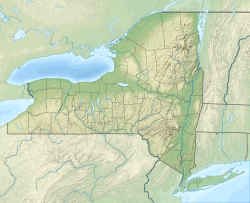Rome, New York | |
|---|---|
City | |
 Oneida County Courthouse | |
| Nickname: The Copper City | |
| Motto: Center of It All | |
 Location within Oneida County and New York | |
| Coordinates: 43°13′10″N 75°27′48″W / 43.21944°N 75.46333°W | |
| Country | United States |
| State | New York |
| County | Oneida |
| Incorporated | 1870 |
| Government | |
| • Type | Mayor-Council |
| • Mayor | Jeffrey M. Lanigan (R) |
| Area | |
| • Total | 75.66 sq mi (195.95 km2) |
| • Land | 74.85 sq mi (193.87 km2) |
| • Water | 0.80 sq mi (2.08 km2) 0.99% |
| Elevation | 456 ft (139 m) |
| Population (2020) | |
| • Total | 32,127 |
| • Density | 429.20/sq mi (165.71/km2) |
| Time zone | UTC−5 (Eastern (EST)) |
| • Summer (DST) | UTC−4 (EDT) |
| Area code | 315 |
| FIPS code | 36-63418 |
| GNIS feature ID | 0962840 |
| Website | romenewyork.com |
Rome is a city in Oneida County, New York, United States, located in the central part of the state. The population was 32,127 at the 2020 census.[2] Rome is one of two principal cities in the Utica–Rome Metropolitan Statistical Area, which lies in the "Leatherstocking Country" made famous by James Fenimore Cooper's Leatherstocking Tales, set in frontier days before the American Revolutionary War. Rome is in New York's 22nd congressional district.
The city developed at an ancient portage site of Native Americans, including the historic Iroquois nations. This portage continued to be strategically important to Europeans, who also used the main 18th and 19th-century waterways, based on the Mohawk and Hudson rivers, that connected New York City and the Atlantic seaboard to the Great Lakes. The original European settlements developed around fortifications erected in the 1750s to defend the waterway, in particular the British Fort Stanwix (1763) built in New York.
Following the American Revolution, the settlement began to grow with the construction of the Rome Canal in 1796, to connect Wood Creek (leading from Lake Ontario) and the headwaters of the Mohawk River. In the same year the state created the Town of Rome as a section of Oneida County. For a time, the small community next to the canal was informally known as Lynchville, after the original owner of the property, the prominent wine merchant Dominick Lynch.[3][4][5]
The New York State Legislature converted the Town of Rome into a city on February 23, 1870.[6] The residents have called Rome the City of American History.[7]
- ^ "ArcGIS REST Services Directory". United States Census Bureau. Retrieved September 20, 2022.
- ^ "Explore Census Data". data.census.gov. Retrieved July 17, 2022.
- ^ "Dominick Lynch gave Rome streets, parks, and building sites". Archived from the original on October 23, 2022. Retrieved October 23, 2022.
- ^ Zackey, Christopher. "The Naming of Rome, NY". Jervis Public Library, Rome, NY. Archived from the original on October 13, 2011. Retrieved June 26, 2012. This webpage cites several published sources.
- ^ Lemark, Joseph (2008). "Roman Grandeur in Central New York: The Classical Tradition in a Nineteenth-Century Pioneer Town". New York History. 89. Archived from the original on April 28, 2012. This article mainly discusses Elmira, New York, but also explains the tradition in the federal period of naming Upstate New York towns and cities after classical sites.
- ^ Canfield, William Walker; Clark, J. E. (1909). Things worth knowing about Oneida County. T. J. Griffiths. p. 88. Retrieved February 12, 2016.
- ^ Rome, N.Y.: "the City of American History.". City of Rome. 1982. No online version.

